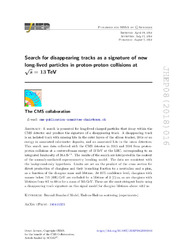Search for disappearing tracks as a signature of new long-lived particles in proton-proton collisions at s√=13 TeV
| dc.contributor.author | Sirunyan, A. M. | |
| dc.contributor.author | Işıldak, Bora | |
| dc.date.accessioned | 2019-03-27T07:29:16Z | |
| dc.date.available | 2019-03-27T07:29:16Z | |
| dc.date.issued | 2018-08 | |
| dc.identifier.issn | 1029-8479 | en_US |
| dc.identifier.uri | http://hdl.handle.net/10679/6228 | |
| dc.identifier.uri | https://link.springer.com/article/10.1007/JHEP08%282018%29016 | |
| dc.description.abstract | A search is presented for long-lived charged particles that decay within the CMS detector and produce the signature of a disappearing track. A disappearing track is an isolated track with missing hits in the outer layers of the silicon tracker, little or no energy in associated calorimeter deposits, and no associated hits in the muon detectors. This search uses data collected with the CMS detector in 2015 and 2016 from proton-proton collisions at a center-of-mass energy of 13 TeV at the LHC, corresponding to an integrated luminosity of 38.4 fb(-1). The results of the search are interpreted in the context of the anomaly-mediated supersymmetry breaking model. The data are consistent with the background-only hypothesis. Limits are set on the product of the cross section for direct production of charginos and their branching fraction to a neutralino and a pion, as a function of the chargino mass and lifetime. At 95% confidence level, charginos with masses below 715 (695) GeV are excluded for a lifetime of 3 (7) ns, as are charginos with lifetimes from 0.5 to 60 ns for a mass of 505 GeV. These are the most stringent limits using a disappearing track signature on this signal model for chargino lifetimes above approximate to 0.7 ns. | en_US |
| dc.description.sponsorship | BMWFW and FWF (Austria); FNRS and FWO (Belgium); CNPq, CAPES, FAPERJ, and FAPESP (Brazil); MES (Bulgaria); CERN; CAS, MoST, and NSFC (China); COLCIENCIAS (Colombia); MSES and CSF (Croatia); RPF (Cyprus); SENESCYT (Ecuador); MoER, ERC IUT, and ERDF (Estonia); Academy of Finland, MEC, and HIP (Finland); CEA and CNRS/IN2P3 (France); BMBF, DFG, and HGF (Germany); GSRT (Greece); NKFIA (Hungary); DAE and DST (India); IPM (Iran); SFI (Ireland); INFN (Italy); MSIP and NRF (Republic of Korea); LAS (Lithuania); MOE and UM (Malaysia); BUAP, CINVESTAV, CONACYT, LNS, SEP, and UASLP-FAI (Mexico); MBIE (New Zealand); PAEC (Pakistan); MSHE and NSC (Poland); FCT (Portugal); JINR (Dubna); MON, RosAtom, RAS and RFBR (Russia); MESTD (Serbia); SEIDI, CPAN, PCTI and FEDER (Spain); Swiss Funding Agencies (Switzerland); MST (Taipei); ThEPCenter, IPST, STAR, and NSTDA (Thailand); TUBITAK and TAEK (Turkey); NASU and SFFR (Ukraine); STFC (United Kingdom); DOE and NSF (U.S.A.).r Individuals have received support from the Marie-Curie program and the European Research Council and Horizon 2020 Grant, contract No. 675440 (European Union); the Leventis Foundation; the A. P. Sloan Foundation; the Alexander von Humboldt Foundation; the Belgian Federal Science Policy Office; the Fonds pour la Formation a la Recherche dans l'Industrie et dans l'Agriculture (FRIA-Belgium); the Agentschap voor Innovatie door Wetenschap en Technologie (IWT-Belgium); the F.R.S.-FNRS and FWO (Belgium) under the "Excellence of Science - EOS" - be.h project n. 30820817; the Ministry of Education, Youth and Sports (MEYS) of the Czech Republic; the Lendulet ("Momentum") Programme and the Janos Bolyai Research Scholarship of the Hungarian Academy of Sciences, the New National Excellence Program UNKP, the NKFIA research grants 123842, 123959, 124845, 124850 and 125105 (Hungary); the Council of Science and Industrial Research, India; the HOMING PLUS program of the Foundation for Polish Science, cofinanced from European Union, Regional Development Fund, the Mobility Plus program of the Ministry of Science and Higher Education, the National Science Center (Poland), contracts Harmonia 2014/14/M/ST2/00428, Opus 2014/13/B/ST2/02543, 2014/15/B/ST2/03998, and 2015/19/B/ST2/02861, Sonata-bis 2012/07/E/ST2/01406; the National Priorities Research Program by Qatar National Research Fund; the Programa Estatal de Fomento de la Investigacion Cientifica y Tecnica de Excelencia Maria de Maeztu, grant MDM-2015-0509 and the Programa Severo Ochoa del Principado de Asturias; the Thalis and Aristeia programs cofinanced by EU-ESF and the Greek NSRF; the Rachadapisek Sompot Fund for Postdoctoral Fellowship, Chulalongkorn University and the Chulalongkorn Academic into Its 2nd Century Project Advancement Project (Thailand); the Welch Foundation, contract C-1845; and the Weston Havens Foundation (U.S.A.). | |
| dc.language.iso | eng | en_US |
| dc.publisher | Springer Nature | en_US |
| dc.relation.ispartof | Journal of High Energy Physics | |
| dc.rights | openAccess | |
| dc.title | Search for disappearing tracks as a signature of new long-lived particles in proton-proton collisions at s√=13 TeV | en_US |
| dc.type | Article | en_US |
| dc.description.version | Publisher version | en_US |
| dc.peerreviewed | yes | en_US |
| dc.publicationstatus | Published | en_US |
| dc.contributor.department | Özyeğin University | |
| dc.contributor.authorID | (ORCID 0000-0002-0283-5234 & YÖK ID 124605) Işıldak, Bora | |
| dc.contributor.ozuauthor | Işıldak, Bora | |
| dc.identifier.volume | 2018 | en_US |
| dc.identifier.issue | 8 | en_US |
| dc.identifier.wos | WOS:000441224700003 | |
| dc.identifier.doi | 10.1007/JHEP08(2018)016 | en_US |
| dc.subject.keywords | Beyond standard model | en_US |
| dc.subject.keywords | Hadron-Hadron scattering (experiments) | en_US |
| dc.identifier.scopus | SCOPUS:2-s2.0-85051465294 | |
| dc.contributor.authorMale | 1 | |
| dc.relation.publicationcategory | Article - International Refereed Journal - Institutional Academic Staff |
Files in this item
This item appears in the following Collection(s)
Share this page



